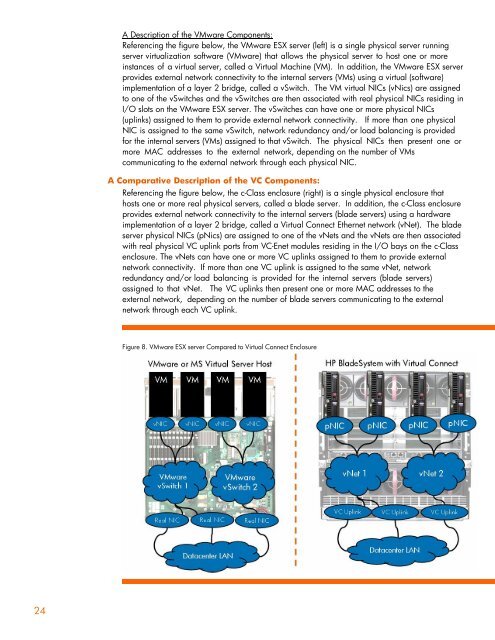HP Virtual Connect for the Cisco Network Administrator
HP Virtual Connect for the Cisco Network Administrator
HP Virtual Connect for the Cisco Network Administrator
Create successful ePaper yourself
Turn your PDF publications into a flip-book with our unique Google optimized e-Paper software.
24<br />
A Description of <strong>the</strong> VMware Components:<br />
Referencing <strong>the</strong> figure below, <strong>the</strong> VMware ESX server (left) is a single physical server running<br />
server virtualization software (VMware) that allows <strong>the</strong> physical server to host one or more<br />
instances of a virtual server, called a <strong>Virtual</strong> Machine (VM). In addition, <strong>the</strong> VMware ESX server<br />
provides external network connectivity to <strong>the</strong> internal servers (VMs) using a virtual (software)<br />
implementation of a layer 2 bridge, called a vSwitch. The VM virtual NICs (vNics) are assigned<br />
to one of <strong>the</strong> vSwitches and <strong>the</strong> vSwitches are <strong>the</strong>n associated with real physical NICs residing in<br />
I/O slots on <strong>the</strong> VMware ESX server. The vSwitches can have one or more physical NICs<br />
(uplinks) assigned to <strong>the</strong>m to provide external network connectivity. If more than one physical<br />
NIC is assigned to <strong>the</strong> same vSwitch, network redundancy and/or load balancing is provided<br />
<strong>for</strong> <strong>the</strong> internal servers (VMs) assigned to that vSwitch. The physical NICs <strong>the</strong>n present one or<br />
more MAC addresses to <strong>the</strong> external network, depending on <strong>the</strong> number of VMs<br />
communicating to <strong>the</strong> external network through each physical NIC.<br />
A Comparative Description of <strong>the</strong> VC Components:<br />
Referencing <strong>the</strong> figure below, <strong>the</strong> c-Class enclosure (right) is a single physical enclosure that<br />
hosts one or more real physical servers, called a blade server. In addition, <strong>the</strong> c-Class enclosure<br />
provides external network connectivity to <strong>the</strong> internal servers (blade servers) using a hardware<br />
implementation of a layer 2 bridge, called a <strong>Virtual</strong> <strong>Connect</strong> E<strong>the</strong>rnet network (vNet). The blade<br />
server physical NICs (pNics) are assigned to one of <strong>the</strong> vNets and <strong>the</strong> vNets are <strong>the</strong>n associated<br />
with real physical VC uplink ports from VC-Enet modules residing in <strong>the</strong> I/O bays on <strong>the</strong> c-Class<br />
enclosure. The vNets can have one or more VC uplinks assigned to <strong>the</strong>m to provide external<br />
network connectivity. If more than one VC uplink is assigned to <strong>the</strong> same vNet, network<br />
redundancy and/or load balancing is provided <strong>for</strong> <strong>the</strong> internal servers (blade servers)<br />
assigned to that vNet. The VC uplinks <strong>the</strong>n present one or more MAC addresses to <strong>the</strong><br />
external network, depending on <strong>the</strong> number of blade servers communicating to <strong>the</strong> external<br />
network through each VC uplink.<br />
Figure 8. VMware ESX server Compared to <strong>Virtual</strong> <strong>Connect</strong> Enclosure

















